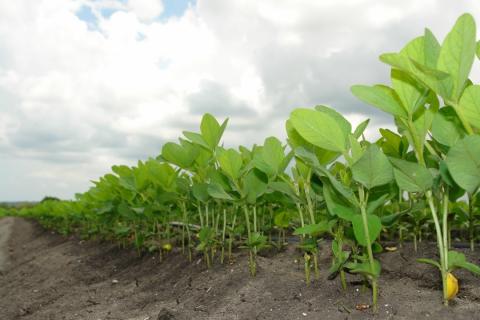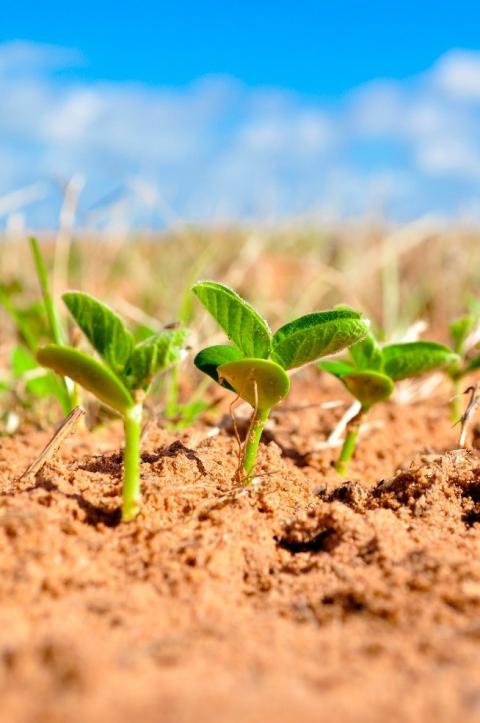Dr William Stiles: IBERS, Aberystwyth University.
- Vegetable based protein for livestock feed in the UK is primarily sourced from soy bean imported from South America.
- Reliance on this source is problematic from an economic, food security and environmental impact perspective.
- Alternative sources of ‘home-grown’ protein for livestock feed are necessary to reduce these effects.
A global increase in the demand for livestock products has driven a rise in demand for protein based animal feeds, which presents certain challenges. Of the vegetable protein sources currently utilised for livestock production, Soybean meal (SBM) is the most widely used in both agriculture and aquaculture. The value of SBM has increased significantly in recent years as demand from developing countries has grown, resulting in increases in the cost of SBM to UK businesses. In addition, SBM production is a concern due to its sizeable environmental impact, both during production and subsequently in distribution from supply sources predominantly in North and South America.
Soybean growing as a crop.
SBM is produced as a by-product of oil extraction and is by far the most popular oilseed crop produced in the world today, representing 55% of the total global production of oilseeds. It is popular for livestock feeds due to high protein contents (44 – 49%) which are highly digestible and possess favourable amino acid profiles. SBM is currently the principal source of vegetable protein for animal feed; however it is problematic due to the increasing cost of this product, the difficulties in sourcing non-genetically modified stocks, the need to improve UK food security in the face of volatile international markets, and the sizeable environmental impact from production and distribution. As a consequence, there is a need to find and develop alternative sources of protein for livestock feed.
Economics of Soybean
World meat consumption is projected to double by 2050. Patterns of meat consumption are changing rapidly across the globe, particularly for developing countries such as China and India, where annual per capita consumption of meat has doubled since 1980. In addition, the demand for high protein vegetable livestock feed has also increased significantly across the UK and Europe since the outbreak of BSE, which revealed the use of bone meal as livestock feed to be hazardous. As a result the price of SBM has risen substantially; in 2001 the price was in the region of £150 per tonne, but by 2016 this had more than doubled with highs in the region of £350 per tonne.
Globally 35% of crop production is allocated to animal feed and 65% to human food. This ratio changes significantly for developed countries, where it favours the production of animal feeds at a ratio nearer 60:40 due to greater demand for livestock products. From this current picture we can estimate that the proportion of land utilised to produce food for livestock to satisfy growing demands for meat products is likely to continue to increase.
Demand has resulted in increases in production, which has benefited some developing nations. Argentina and Brazil are today’s leading exporters of SBM, together capturing 64% of world exports. However, this development may not necessarily improve the quality of life for those involved in production. Soybean production in developing regions has been shown to reduce poverty and raise rural incomes, but this can also increase rates of inequality in local populations, where limited regulation can result in very high earning capacity for producers, which fails to be equally realised by workforces, leading to increased social tension.
Food security
Reliance on imports from the Americas, particularly South America, may expose the UK to vulnerabilities in the food supply chain, both from availability and cost perspectives. This may have significant implications for the UK’s ability to maintain food production, where stability of supply is impossible to govern, and could leave the UK exposed to the financial volatilities of international markets, making meat production potentially highly costly. This may be further compounded by the future availability of non-GM varieties of livestock feed, as these may become more difficult to source and therefore more expensive.
The provenance of food is increasingly important to UK consumers. As a result of the horse meat scandal, the ability to track a product throughout its supply chain journey, from production to plate, is something that retailers are likely to insist upon and something that consumers expect. By virtue of the international supply chain associated with SBM imports concerns exist regarding provenance, particularly with regard to local management practices and total environmental impact.
Environmental impact
Demand for soybean has driven wide scale deforestation to make way for agriculture, particularly in neo-tropical regions of South America. In Argentina the expansion of soybean production has been associated with the loss of 2.7 million ha of forest between 1972 and 2011, with the majority occurring after 2002. In South Brazil soya production has been blamed for the near disappearance of the Atlantic Forest in the 1970s and 80s, highlighting the speed with which entire systems can be transformed.
Neo-tropical forest types, which include tropical rainforest, are particularly important due to the high levels of biological diversity which are supported in these systems. Tropical forests are also immense stores of carbon which is sequestered in vegetation biomass and in organic matter held in soil. Converting tropical forests to agricultural land releases significant amounts of CO2 to the atmosphere. This effect is twofold: firstly, carbon is released through the process of decomposition of organic matter stored in plant biomass and soils after clearance. This also includes carbon loss from timber products exported through forestry practices, which have a lifespan of approximately 60 years. Secondly, an active forest constitutes a carbon sink, as CO2 is drawn from the atmosphere and incorporated into plant biomass through the process of photosynthesis. By reducing forest coverage, the potential for carbon sequestration is also reduced.
Clearing tropical forest to make space for agriculture is a major source of greenhouse gas emissions (estimated to account for between 12-18% of total man-made emissions). The amount of carbon released during the first 50 years after conversion from tropical rainforest to soybean production is estimated to be in the region of 737 Mg CO2 ha-1, which when averaged per year is approximately half the total emissions of CO2 per ha for the entire UK (total emissions/land area – emissions figures from 2014). By allowing production of vegetable protein to remain overseas, then control over environmental impact remains a remote concept. In the context of soya production, where this results in the destruction of virgin forest to make way for agriculture, this may be extremely environmentally damaging and in developing regions of the world, subject to little or limited regulation or oversight.
Summary
Reliance on SBM as a source of protein for animal feed is potentially damaging from an economic, food security and environmental perspective. Establishing secure and cost effective sources of protein for animal feed from new and potentially novel sources, is therefore an important area of research and development.
Fundamentally however, there may be no avoiding the fact that the demand for livestock products may need to be tempered in the future as consumption rates from developing nations continues to grow. Protein from animal products for human consumption requires a conversion of vegetable protein at a ratio of 20:1 for the production of beef (20 kg of plant matter to produce 1 kg beef), which is an extremely inefficient method for producing protein for human consumption. This figure is less for smaller livestock such as lamb, pigs and chickens (estimations vary, but approximately 4-9:1) and in the region of 3:1 for the production of milk. Nevertheless, as future demand for food increases with population growth, finding ways to shift the demand for animal products to less environmentally damaging food sources may prove essential.


